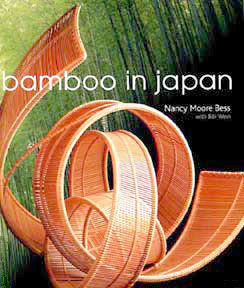
BAMBOO
IN JAPAN
Preface
by
Nancy Moore Bess
|
| BAMBOO Preface |
Basket makers are obsessed with materials,from roots gathered in the towering cedar Forests of the PacificNorthwest to hand-spun linen. And I am no exception. On my firsttrip to Japan in 1986, I planned to explore new materials andimmerse myself in a different culture. Several years earlier,the book How to Wrap Five More Eggs had become a stronginfluence on my basketry work, and I expected to find this influencereinforced by contact with Japanese materials--specifically, bamboo,rice straw, and paper. I had prepared for the trip by spendinglong hours in libraries and in museum exhibits devoted to Asia.As I reread Morse's Japan Day by Day and Statler's JapaneseInn, I made lists of places and planned daily activities.I joined the American Bamboo Society (ABS) in order to learn aboutthe horticulture of bamboo. As a result, I came to realize thepotential of bamboo more fully, and it became the focal pointof my time in Japan.
As my plane circled over Narita airport,my agenda was simply to learn about bamboo as a craft material.I expected to find bamboo baskets, but I had no idea how widethe range, how beautiful the patina, how practical the form wouldbe. In Mary Kahlenberg's A Book about Grass, I had alreadyread about Japanese bamboo fences and analyzed their function.But when I finally saw them for myself, it was their beauty--fromthe simplest to the most complex--that took my breath away. Ihad also read about the majestic thatched farmhouses with theirtowering roof lines, but I hadn't realized how intrinsic a contributionbamboo made, and how beautiful in its massive scale the supportingbamboo grid would be. I didn't know I would love the smooth touchof a bamboo brush handle and smile as I made ink tracings acrosspaper. I hadn't expected to walk down winding roads to a smallcountry train station, enveloped in the shadows of the rustlingbamboo that lined the path. I was startled by the beauty of bambooshoots breaking the ground at a Kamakura temple, their coveringsheaths alive with a purplish glow and minute surface fibers.Nor had I realized that bamboo, in all its incantations, was everywherein Japan.
One of my fondest memories took placeduring this first trip. Sekijima Hisako, the renowned Japanesebasket maker, met me at the small train station near the FujiBamboo Garden in Shizuoka. During the course of our walk throughthe grounds, we stopped between the tall rows of bamboo to eatthe rice balls she had brought. The garden was not crowded, sowe lay back on the grass in the hot sun, looked up at the clouds,and watched the tips of the tall bamboo sway in the breeze. MountFuji was visible in the background. Sekijima, I, and bamboo hadbecome part of a Hokusai ukiyo-e print. Eleven months later,as I stood quietly weeping at the bus stop in front of the airport,I knew bamboo was a passion for life, a passion that requiredsome complicated changes in my goals.
Over the years, my initial responseto bamboo has been enriched by personal experiences, new acquaintances,and a wealth of scholarly information. What began as naive fascinationbecame a thorough study of bamboo's complexity. Every conversation,every email from Japan, every ABS meeting, and every book movedme forward in this learning process. I accumulated thousands ofslides, hundreds of books, and a collection of bamboo artifacts.Eventually, requests to teach and lecture began to include bambooas well as basketry, and these offered opportunities to expandmy knowledge further. The more I taught, the more informationothers provided. When I showed slides of the basket collectionin the National Museum of Ethnology in Osaka, students mentioneda basket maker in Kyushu. When I spoke of the Minka-en in KawasakiCity and the Farmhouse Museum of Osaka (both sites that featuretraditional Japanese buildings), an architect stepped forwardto explain the significance of bamboo in these structures. By1996, with an opportunity for a seven-month stay in the countrysidenear Tokyo, the idea of a book began to take shape. From the initialfocus on bamboo baskets, the final topic--bamboo itself--evolved,and this expansion led me to new resources: the Ukiyo-e Societyof America, bamboo wholesalers, Japanese media, and the museumsand research libraries of Honolulu. I have learned about bamboo'spart in the Japanese language, the design world, the buildingindustry, and national cuisine. I began the process by wonderingabout bamboo in basketry; now I see its influence everywhere.
Sometimes, I think I have gone a bittoo far. American friends say I talk about bamboo incessantly.Japanese friends still look askance on occasion when I introducethe topic, but more often they now admit they see bamboo withnew clarity.
As an observer and a craftsperson, Ioffer this book to those who have yet to experience the wonderof bamboo, as well as to those who have bamboo in their garden,bamboo shoots in their wok, and lovingly fashioned bamboo objectsin their home. Bamboo's contribution to Japanese culture goesfar beyond a mountainside grove or a simple basket. Its presencetouches every aspect of daily life--art, literature, design, food,and crafts. Its warm golden glow can be found in a pair of chopsticksand a garden fence. It is this very warmth and abundance thatI hope will catch your attention as it has mine.
Nancy Moore Bess
Amherst, Massachusetts
Nancy Moore Bess is an internationally known textile and bamboocraftsperson. For the past 30 years, she has been creating uniquebaskets that reflect her research into the cross-cultural, especiallyJapanese, influences on her craft. Her continuing interest inmulticultural art forms led her to explore the structural andaesthetic properties of bamboo. She lectures on basketry and bambooaround the world and is an active member of the American BambooSociety. Her studio is in Amherst, Massachusetts, where she bothweaves and writes.
| Price of Book | Ordering Information |